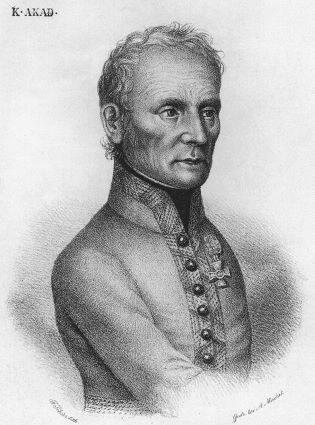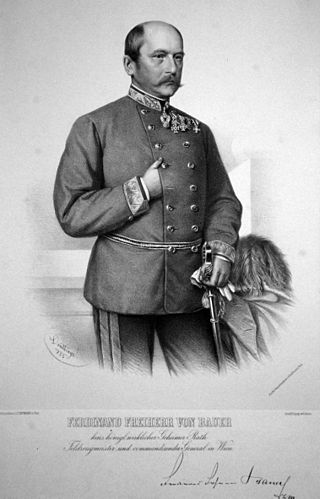Biography
After attending the Wiener Neustadt Military Academy, Wilhelm Ramming was appointed in October 1834 as a lieutenant in the Cuirassier Regiment No. 7, with whom he served for the next five years. On 30 November 1839, he became a lieutenant in the staff of the General Quartermaster. He was promoted to captain on 20 June 1845. During the First Italian War of Independence he served under FML Haynau and participated in the attack on Brescia and the siege of Fort Malghera, as well as in the battles against the insurgents at Pieve di Cadore. On 4 June 1849, he was appointed lieutenant colonel.
During the Hungarian Revolution Ramming took part in the battles at Szered, Raab, Komorn and Szegedin as General Staff of the FZM Haynau. For his services as chief of staff of the army during the summer campaign in Hungary, he was promoted to colonel and awarded the Knight's Cross of the Order of Maria Theresa.
Ramming was ennobled as a baron in 1851. After the peace he remained chief of the general staff of the 3rd Army in Hungary. On 17 May 1854 he was promoted to major general. After he had been chief of the general staff of various army corps for several years, he received a brigade within III. Army Corps and was promoted to Feldmarshall-Leutnant on 28 June 1859.
With his brigade, he took part in the Second Italian War of Independence, where he served in the Battle of Magenta. Thereafer he was assigned to the chief of staff, Heinrich von Heß, as chief of the operations office. After the Peace of Villafranca in 1859, Ramming received the post of Feldmarshall-Leutnant in charge of the operative business in the General Quartermaster's Staff.
In 1864 Ramming was given command of the VI. Army Corps, which he also commanded in the Austro-Prussian War in 1866. Defeated by Steinmetz's V Corps at Náchod on 27 June, Ramming's corps formed the reserve at Skalitz and Sadowa. After the war he served as commanding general in Prague, Sibiu and Brno. In 1868 Ramming was promoted to Feldzeugmeister.
In 1873 he was appointed a lifelong member of the House of Lords.
Wilhelm von Ramming died in Karlsbad on 1 July 1876.

Karl Freiherr Mack von Leiberich was an Austrian officer. He is best remembered as the commander of the Austrian forces that capitulated to Napoleon's Grande Armée in the Battle of Ulm in 1805.

Eduard Freiherr von Böhm-Ermolli was an Austrian general during World War I who rose to the rank of field marshal in the Austro-Hungarian Army. He was the head of the Second Army and fought mainly on the front of Galicia during the entire conflict. On 30 October 1940, Böhm-Ermolli was made a German Generalfeldmarschall.

Julius Jakob Freiherr von Haynau was an Austrian general who suppressed insurrectionary movements in Italy and Hungary in 1848 and later. While a hugely effective military leader, he also gained renown as an aggressive and ruthless commander. His soldiers called him the "Habsburg Tiger"; those opponents who suffered from his brutality called him the "Hyena of Brescia" and the "Hangman of Arad".

Ludwig August Ritter von Benedek, also known as Lajos Benedek, with the Hungarian form of Ludwig, was an Austro-Hungarian general (Feldzeugmeister), best known for commanding the imperial army in 1866 in their defeat at the Battle of Königgrätz against the Prussian Army, which ended his career.

Generaloberst Arthur Freiherr Arz von Straußenburg was an Austro-Hungarian colonel general and last Chief of the General Staff of the Austro-Hungarian Army. At the outbreak of the First World War, he commanded the 15th Infantry Division. Soon, he was promoted to the head of the 6th Corps and the First Army. He participated on the Gorlice–Tarnów Offensive in 1915 and the countryside of Romania in 1916. In March 1917, he became Chief of the General Staff until his resignation on 3 November 1918.

Paul Freiherr Puhallo von Brlog was a general of Austria-Hungary. During World War I, he commanded the Austro-Hungarian Army's 3rd and 1st Armies.
Lieutenant field marshal, also frequently historically field marshal lieutenant, was a senior army rank in certain European armies of the 17th to 20th centuries. It emerged as the rank of field marshal came to be used for the highest army commander in the 17th century. In German-speaking countries the commander-in-chief usually appointed an "under marshal" or "lieutenant field marshal" to support and represent the field marshal. Amongst his functions as the personal deputy to the field marshal, were the supervision of supply depots and routes, and inspection of the guards.
The following units and commanders took part in the Battle of Königgrätz on July 3, 1866. Compiled from the Prussian Army's Official History of the war.

Joseph Freiherr Maroicic von Madonna del Monte was an Austrian general of Croatian descent.

Nikolaus Wilhelm Freiherr Lenk von Wolfsberg was an Austrian officer (Feldzeugmeister), owner of the Corps Artillery Regiment No. 4 and scientist.

Ludwig Karl Wilhelm Freiherr von Gablenz was an Austrian general of Saxon origin.
Ernst Ritter von Hartung was an Austrian Feldzeugmeister and military theorist.

Franz Freiherr von John was an Austrian Feldzeugmeister, Chief of the General Staff, and Minister of War.

Franz Kuhn von Kuhnenfeld was an Austro-Hungarian military officer who fought against Giuseppe Garibaldi in the wars of Italian independence and served as Imperial and Royal Minister of War from 1868 to 1874. During his term, a unified system of conscription for both Cisleithania and Transleithania was introduced, corporal punishment in military service was abolished, and the Franz-Josephinian Land Survey was initiated. He was a supporter of the Austro-Hungarian polar expedition and an opponent of the Austria-Hungary's 1879 alliance with the German Empire.

Ferdinand von Bauer, born Ferdinand Bauer was a general of the Austro-Hungarian Common Army and the Imperial and Royal Minister of War from 1888 until his death in 1893.

Edmund Freiherr von Krieghammer was an Austrian General of the Cavalry and Imperial and Royal Minister of War of Austria-Hungary.

Friedrich Peter Freiherr Duka von Kádár was of Croatian Serb ancestry privy councillor, officer (Feldzeugmeister) and owner of the Hungarian Infantry Regiment No. 39, then State and Conference Council of the Emperor. He was a recipient of the Knight's Cross of the Military Order of Maria Theresa. He is remembered as a great adversary of Napoleon and to have negotiated an armistice with him at Lusigny-sur-Barse.

Ludwig Goiginger was an Austro-Hungarian Lieutenant Field Marshal who notably served in World War I.

Karl von Thun und Hohenstein was an Austrian officer who was notable for being the main Austrian commander at the Battle of Blumenau of the Austro-Prussian War.

Anton Mollinary Freiherr von Monte Pastello was an Austro-Hungarian General of the Artillery and writer. He was known for being the Deputy of the 4th Corps during the Battle of Königgrätz and had an extensive campaign within mid 19th-century conflicts involving Austria.
This page is based on this
Wikipedia article Text is available under the
CC BY-SA 4.0 license; additional terms may apply.
Images, videos and audio are available under their respective licenses.

















